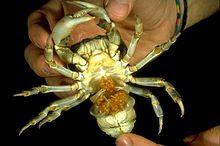| Pleocyemata | |
|---|---|
 | |
| Ovigerous female Potamon fluviatile with the pleon held open to show the eggs held on the pleopods | |
| Scientific classification | |
| Kingdom: | Animalia |
| Phylum: | Arthropoda |
| Subphylum: | Crustacea |
| Class: | Malacostraca |
| Order: | Decapoda |
| Suborder: | Pleocyemata Burkenroad, 1963 |
| Infraorders | |
| |
Pleocyemata is a suborder of decapod crustaceans, erected by Martin Burkenroad in 1963.[1] Burkenroad's classification replaced the earlier sub-orders of Natantia and Reptantia with the monophyletic groups Dendrobranchiata (prawns) and Pleocyemata. Pleocyemata contains all the members of the Reptantia (including crabs, lobsters, crayfish, and others), as well as the Stenopodidea (which contains the so-called "boxer shrimp" or "barber-pole shrimp"), and Caridea, which contains the true shrimp. Pleocyemata comprises the following infraorders:[2]
- Stenopodidea (stenopodidean shrimp)
- Caridea (caridean shrimp)
- Astacidea (true lobsters, reef lobsters, and crayfish)
- Glypheidea (glypheoid lobsters)
- Axiidea (mud lobsters and ghost shrimp)
- Gebiidea (mud lobsters and mud shrimp)
- Achelata (spiny, slipper, and furry lobsters)
- Polychelida (benthic crustaceans)
- Anomura (squat lobsters, hermit crabs, and relatives)
- Brachyura (true crabs)
These taxa are united by a number of features, the most important of which is that the fertilised eggs are incubated by the female, and remain stuck to the pleopods (swimming legs) until the zoea larvae are ready to hatch. It is this characteristic that gives the group its name. Pleocyemata also possess a lamellar gill structure as opposed to the branched found in Dendrobranchiata.
The earliest fossil representative is the Devonian Palaeopalaemon.[3]
References
- ^ Burkenroad, M. D. (1963). "The evolution of the Eucarida (Crustacea, Eumalacostraca), in relation to the fossil record". Tulane Studies in Geology. 2 (1): 1–17.
- ^ Sammy De Grave; N. Dean Pentcheff; Shane T. Ahyong; et al. (2009). "A classification of living and fossil genera of decapod crustaceans" (PDF). Raffles Bulletin of Zoology. Suppl. 21: 1–109.
- ^ Robert P. D. Crean (November 14, 2004). "Order Decapoda: Fossil record and evolution". University of Bristol. Archived from the original on February 29, 2012. Retrieved January 2, 2010.